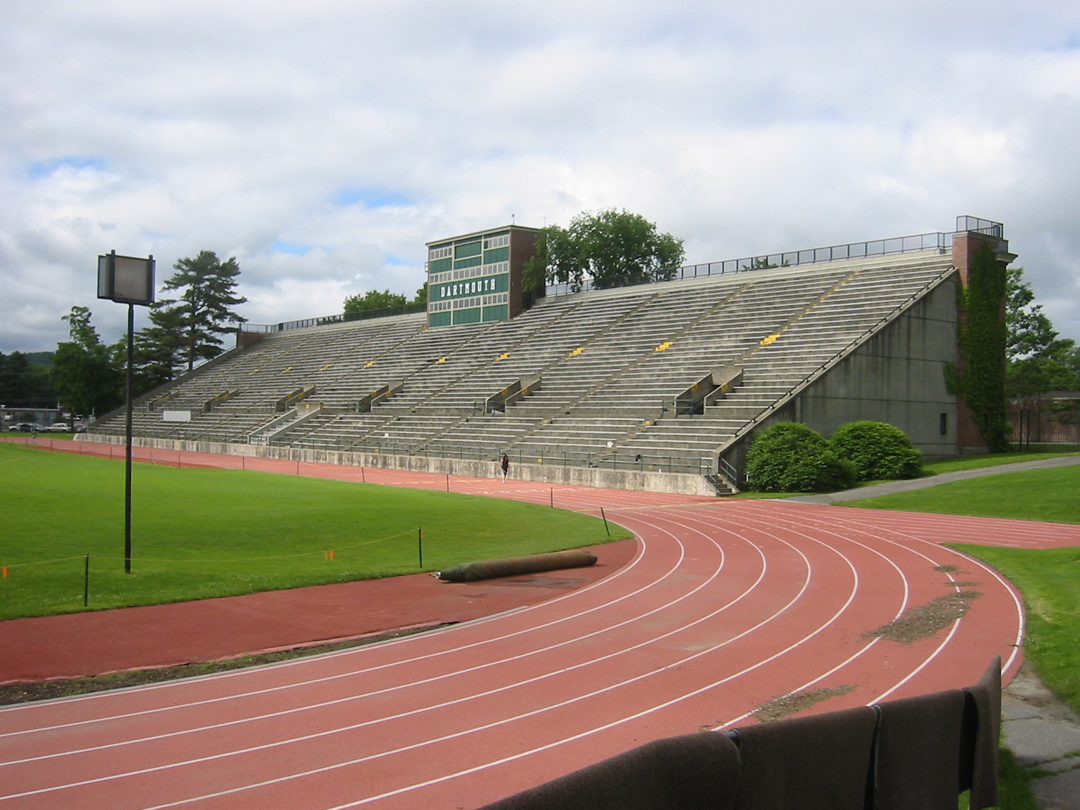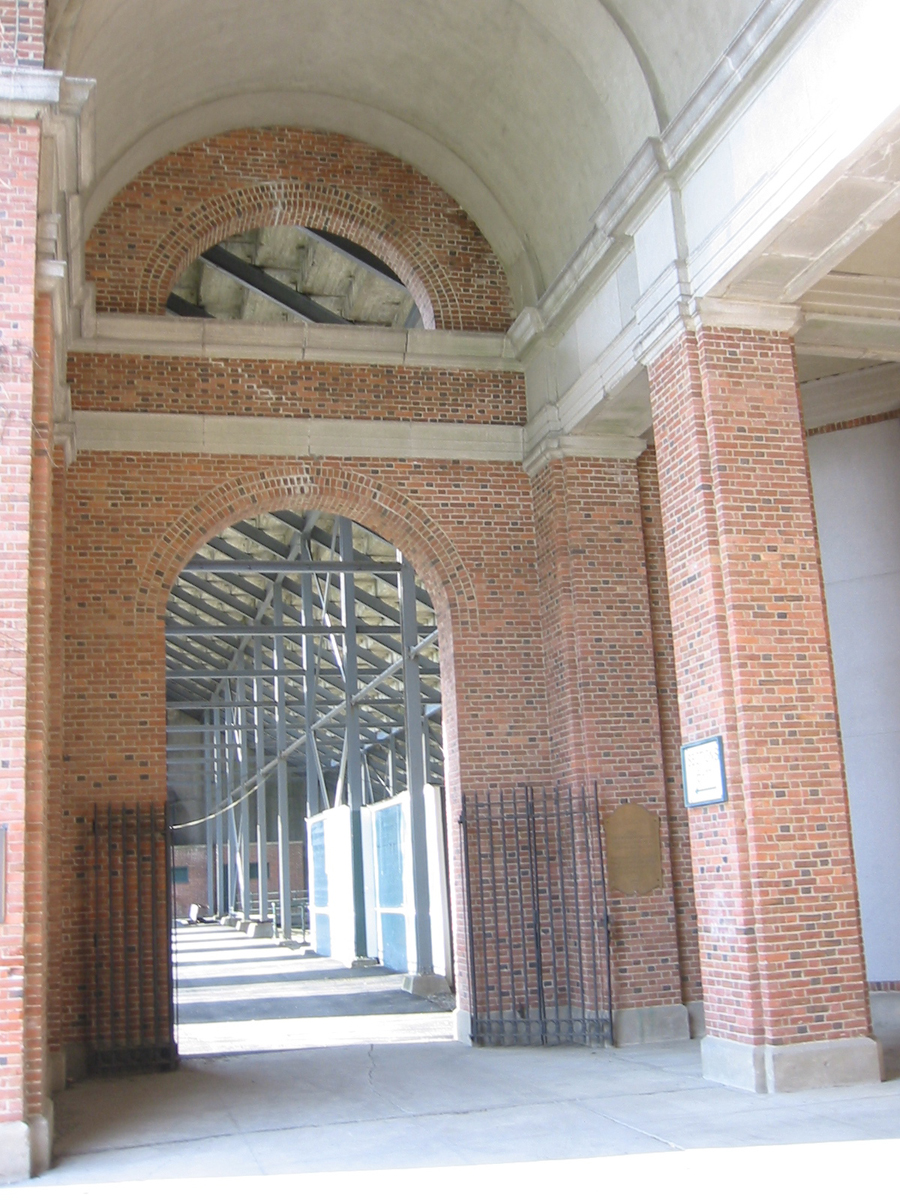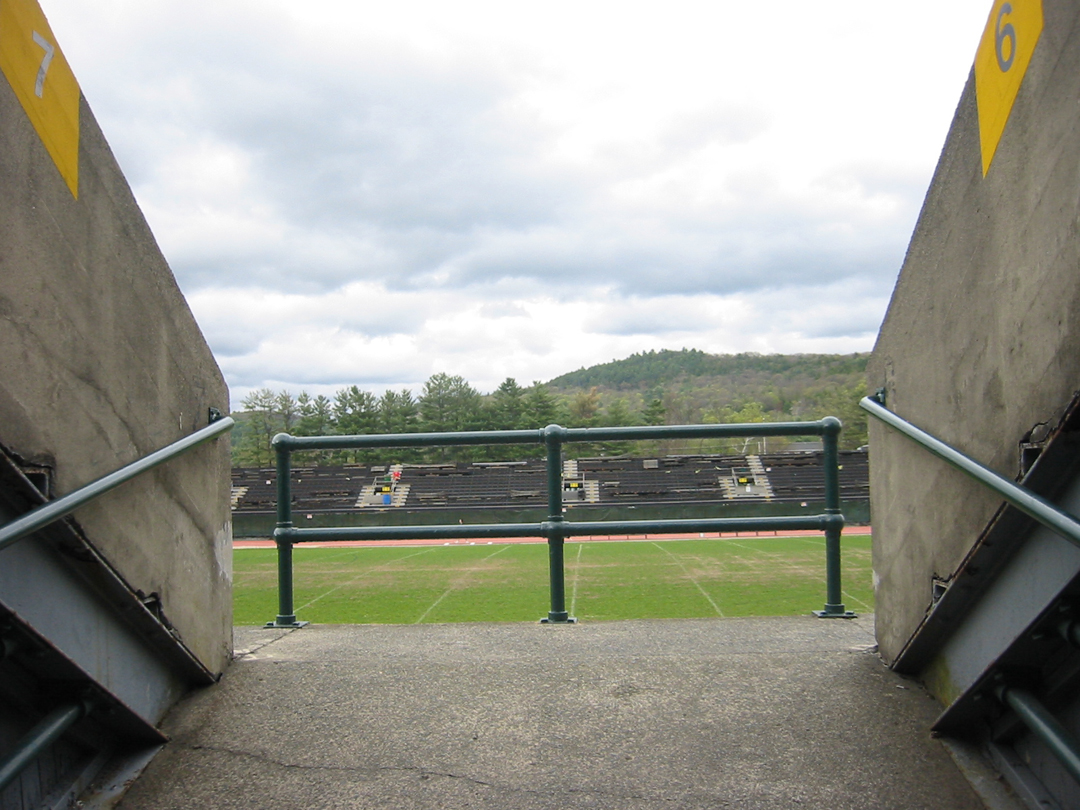- Jens Larson is on the cover of a Bucknell University magazine from 2009 (pdf). The cover story describes his 1932 master plan in the context of new plan by SBRA.
- The roof of Alumni Gym over the Michael Pool is to be renovated again (The Dartmouth).
- Clement Meadmore’s 1978 COR-TEN sculpture Perdido has been installed on East Wheelock Street below South Fayerweather Hall (Hood press release pdf, Flickr photo of installation, Facebook photo).
- Collis renovations are nearing an end (The Dartmouth), and people are talking about switching fuels for the Heating Plant (The Dartmouth).
- Bruce Wood discusses the possibility of a hockey game on the turf at Memorial Field (Big Green Alert blog).
- Rauner presents interesting research on the conch that students blew as a horn instead of ringing a bell during the eighteenth century (Rauner Library Blog).
- The Valley News has a remembrance of timber framer Edward Levin ’69.
- Interior demolition soon will begin at 4 Currier, where the college is building a 3,000 s.f. innovation center (The Dartmouth).
- Telemark Shortline, the sculpture now located in front of Richardson Hall, has an interesting past as described by the Hood Museum:
Telemark Shortline was originally designed by the artist for a specific site between the Hopkins Center and Wilson Hall on Dartmouth’s campus. When construction commenced on the Hood Museum of Art in 1982, the work was removed. In 2009, it was re-constituted by the artist in its current location. The first part of the title comes from the sculpture’s form, which resembles a deep-snow turn made with a pair of Nordic skis. “Shortline” refers to both the railroad company name (the sculpture’s composition brings to mind railroad tracks) and the artist’s term for the bevel-cut ends of his beams.
- The post on traffic patterns around the Green has been updated.
Category Archives: Memorial Field
Triangle House project begins, other items
- The Dartmouth reports that work has begun on the extensive renovation of the apartment house at 4 North Park Street, to be known as Triangle House.
- College Photographer Eli Burakian has posted some superb aerials of Baker and the Green. The latter image shows downtown Hanover and in the distance the hospital, the smokestack of each communicating with the other as if these were The Only Two Places in the World. See also the Mt. Moosilauke panorama.
- Stantec notes that it worked on Dartmouth’s master plan. One assumes that this was a prior plan, but since the site also lists the recent Dartmouth Row programming study, it’s not clear.
- Bertaux + Iwerks Architects has info on the 2005 SBRA master plan for DHMC.
- A new film on the Densmore Brick Company was shown at AVA Gallery; see also the Valley News story and this depressing Bing aerial. From AVA Gallery:
Lebanon’s Densmore Brick Factory, which closed in 1976 after 170 years of production, made the bricks that contributed to the built environment of the Upper Valley, including much of Dartmouth College.
- The field-side view of Davis Varsity House is improved by the removal of the scoreboard, Bruce Wood points out (Big Green Alert blog).
- The Rauner blog has an interesting post on the correspondence between Samson Occom and Phillis Wheatley (Wikipedia).
- The Band’s new uniforms look good (see Flickr photo). They are more “Ivy” and expensive-looking than the previous plain green blazers over white pants. Black seems to be replacing white as the accent color accompanying Dartmouth Green these days.
- A July article in the New York Times told of Yale’s efforts to protect its name against a “Yale Academy.” As an aside, I found Yale’s recent presidential inauguration inspiring. After the ceremony the band, wearing academic gowns, led the procession up Hillhouse Avenue, where the president passed beneath a balloon arch and halted in the middle of the street between two lines of student singers. The music stopped and everyone sang Bright College Years. Fantastic. The day before, a dean carrying a yale’s head (Wikipedia) on a staff had led a dog parade around Cross Campus (New Haven Register).
- Better than having a hockey game at Fenway Park, Virginia Tech and Tennessee will play a football game at the Bristol Motor Speedway, a Nascar track (Richmond Times Dispatch).
Nicknames for Memorial Field
Bruce at the Big Green Alert Blog asks “If you could pick a nickname for Dartmouth’s Memorial Field, what would you choose?” He provides several suggestions, the best of which is “the Quarry” — not only did granite quarries operate in Lebanon, but Eleazar Wheelock quarried some stone in the College Park. A follow-up post provides a number of other suggestions.
A pool of potential nicknames based on the history of the site might include:
- “The Farm” (or “the State Farm”), since the state agricultural school (New Hampshire College) used the site as a farm field prior to 1893;
- “Crosby Street,” since the grandstand is located on that street. The street is presumably named for the able and indefatigable1History of the University of New Hampshire: 1866-1941 (Durham, N.H.: University of New Hampshire, 1941), 23. professor Thomas Russell Crosby ’41, DMS ’41 (1816-1872), a son of Dr. Asa Crosby who served as a surgeon during the Civil War and became the Professor of Animal and Vegetable Physiology at N.H.C. and an Instructor in Natural History at Dartmouth2John Badger Clarke, Sketches of Successful New Hampshire Men (Manchester, N.H.: author, 1882), 248.;
- “The Oval” (or “Alumni Oval”), since that was the name of the school’s first grandstand and its first dedicated football field and running track, built by Dartmouth alumni on the site in 1893;
- “The Trenches” (or “the Western Front,” etc.), since students trained for the First World War by constructing trenches east of the Oval, and Memorial Field was built on the site of the Oval in memory of the men who died in the war; and
- “The Arches” (or “the Arcade”), since the main, western stand of Memorial Field is faced with brick arches stacked on two levels.
To see what Alumni Oval looked like when it was new and get a sense of the farm that preceeded it, see this rare and amazing photograph digitized by the College Archives. It was taken from the top of the smokestack of the Heating Plant when the plant was new, around 1899.3The photographer took other shots to the north over Hallgarten, to the northwest toward the Green, to the west toward the side of the Inn, and to the southwest over the town.
It is also possible that the present lack of a nickname suggests the absence of a deep-seated need for a nickname: maybe “Memorial Field” works well enough.
—–
[Update 11.11.2013: Bruce reports that Teevens picked “The Woods” as the nickname. Whose woods these are I think I know.]
——
| ↑1 | History of the University of New Hampshire: 1866-1941 (Durham, N.H.: University of New Hampshire, 1941), 23. |
|---|---|
| ↑2 | John Badger Clarke, Sketches of Successful New Hampshire Men (Manchester, N.H.: author, 1882), 248. |
| ↑3 | The photographer took other shots to the north over Hallgarten, to the northwest toward the Green, to the west toward the side of the Inn, and to the southwest over the town. |
A new video scoreboard at the other end of Memorial Field
The announcement of a new Daktronics video scoreboard for Memorial Field includes an illustration (via Big Green Alert Blog; see also Dartmouth Sports).
Although any scoreboard will have something to quibble with (please drop the trademark symbol from the big letter D!) this illustration has many things to praise. The designer has rationalized the fonts and eliminated much of the clutter of the old scoreboard. The designer also deserves credit for not using the ephemeral triangular-trapezoidal athletics logo and for getting the apostrophes right.
Here’s something notable: the scoreboard will be switching ends:
The new Daktronics scoreboard will be located at the south end of the stadium to avoid direct sunlight and maximize image clarity.
What Baseball knows about Memorial Field
Remember last July, when it was pointed out here that a baseball team recruiting document was claiming that the stalled Memorial Field West Stand replacement project would be completed by September of 2012?
The updated version of the document (pdf) now claims that the project will be completed by September of 2013.
It is obviously not going to happen. (It is also not clear how someone could edit that document without improving the text…)
The scoreboard of the future
The Dartmouth writes on proposed amendments to the Town’s zoning ordinances, including amendments that deal with athletic scoreboards. The minutes of the Planning Board from February 5 (pdf) state that Dartmouth has eight outdoor scoreboards and provide this background:
Bob Ceplikas, Deputy Director of Dartmouth Athletics, said there have been a lot of changes over the years with the set-up of Division 1 sports venues, including technology. It is more and more standard for Division 1 football stadiums to include video displays in their scoreboards. Dartmouth is now the only Ivy League school that does not provide video display. The Ordinance’s current language does not allow for scoreboards to exist as they currently do; it does not even allow for the score to be displayed. The Ordinance should be brought up to date to reflect the real purpose of an athletic scoreboard.
No comment on the possibility of a video display (one of the thrills of seeing a college football game in person is the presence of it: there is no replay, so you have to pay attention), but the idea that the scoreboard at Memorial Field could be redesigned is intriguing.
A generous donation of the Class of 1966, the scoreboard is informative, traditional, and appealing — but it could be made even better. The number of typefaces could be reduced from five or so to three. The various vertical surfaces could be brought into the same plane. The “TIME OUTS LEFT” text could be aligned in a more balanced way. A little more space could be given inside some of the white borders, and the general crowding and busyness could be reduced.
—–
[Update 06.09.2013: The text of the ordinance, as found in the March 12 Planning Board minutes (pdf), prohibits advertising:
Athletic scoreboards may display:
A. Information pertinent to the event and facility
B. Recognition of donors and sponsors by name only
C. Other general athletic or institutional information
D. Any other information customarily displayed on contemporary scoreboards, but not to include commercial advertising.
That should remove some concerns.]
Memorial Field West Stand demo going ahead?
Several years ago Dartmouth planned to demolish and replace the terraced steel-and-concrete seating structure of the main stand at Memorial Field, preserving the screening brick facade on Crosby Street.
Then, in December of 2008, Provost Scherr wrote in a letter that “[t]he full renovation of the West Stands was originally scheduled for November 2008-August 2009. The decision to defer is due to the current global economic downturn, which is impacting Dartmouth, as well as many other institutions.”
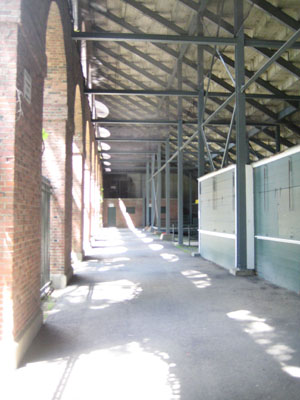
Now a baseball recruiting presentation (pdf), undated but describing the 2012 season, provides this interesting tidbit:
| Project | Cost | Year Completed |
| […] | […] | […] |
| Memorial Field West Stand Replacement | $ 16 Million | Sept. 2012 |
Hmmm.
—–
[Update 11.17.2012: Broken link to baseball presentation fixed.]
[Update 07.16.2012: In other words, this is a strangely specific mistake for the baseball team to make. One can imagine how an old date, such as August of 2009, might have been left in the presentation over the years; but was the project ever scheduled to finish during September of 2012? Aren’t the $16 million price tag and the September date rather arbitrary to be pure oversights? Who knows where this information came from…]
The next Visual Arts Center
I. Introduction
The nearing completion of the Visual Arts Center points up the current underuse of the site next door at the corner of Crosby and Lebanon Streets.
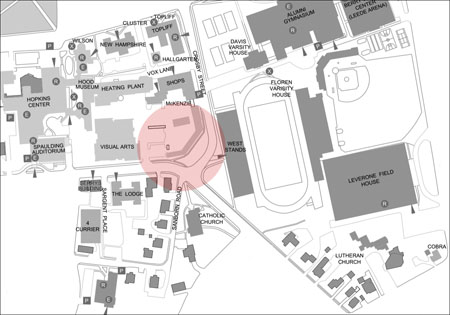
This is a large and important site. Whatever building goes here — let’s assume it is an arts-related building — will be visible to visitors arriving on Lebanon Street. It will need to be a gateway building, as the 2000 downtown Hanover plan illustrates so thoroughly. The Rogers Marvel 2002 Arts Center Analysis (pdf) also emphasizes the potential of this site on page 38.
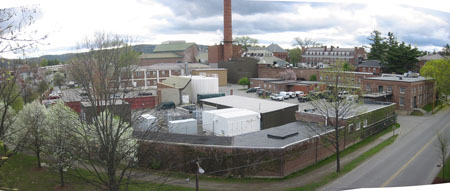
The first impulse is to follow the footprint of the existing low-scale facilities building. But this site is not only large, it is also unusually malleable. The college and town might be able to relocate Crosby Street in radical ways to completely reshape the ground available for the gateway building.
Why might Crosby be changeable? Because it has been changed in the past. Crosby Street was first laid out in 1872, to separate the state farm on the east from the state college dormitory site and other buildings on the west.
Crosby Street originally ran straight through to Lebanon Street. It was not until the early 1960s that Crosby’s southern delta was given its current incongruously suburban form. When Dartmouth sought permission to close down South College Street for the Hopkins Center, the Town asked Dartmouth to rework Crosby Street in return, aligning the street with Sanborn Road to form an ex post facto four-way intersection.
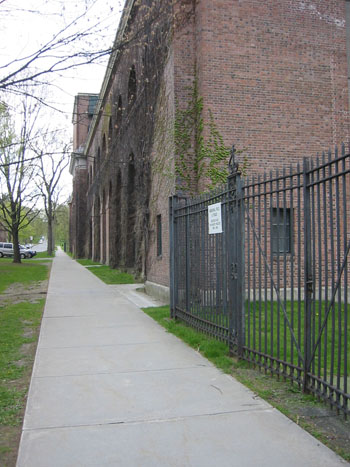
Should we worry about Sanborn Road if Crosby is realigned? No. In fact, the downtown Hanover plan proposes in text and an illustration that Sanborn Road be blocked off. Instead, Hovey Lane will give access to this neighborhood through a short outlet punched through to South Street (see map below).
Would the abandonment of Crosby Street’s current alignment open up any possibilities for a college building on the corner? Each of the following proposals assumes that McKenzie Hall/Shops on Crosby is preserved; Sanborn Road is rerouted; and commercial buildings are built on the college land along the south side of Lebanon Street.
II. The Maximum Arts
The gateway building could expand to fill all of the empty land added to the corner:
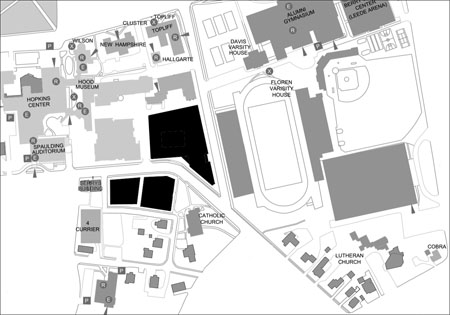
This plan would block an important view of Memorial Field and make Crosby Street into a narrow tunnel. A good use of space, but not good preservation or townscape.
Some variation on this plan, however, might be a good one:
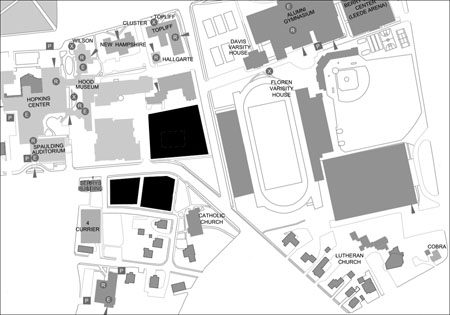
III. The Minimum Arts
Crosby could be pulled to the west, adding a big empty lawn in front of Memorial Field:
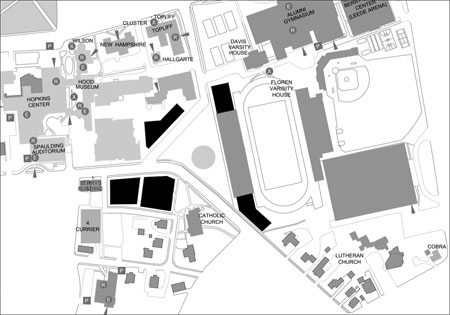
This plan would not make efficient use of space, and its creation of new lawns would not actually improve the view of Memorial Field.
IV. The Square and Temple
A big public square could be carved out of the surrounding buildings:
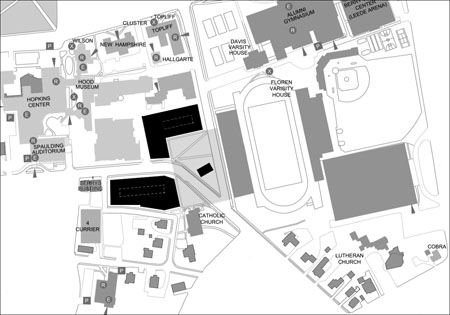
If the big square feels barren, a little temple that shares an alignment with nothing else could be dropped down in front of Memorial Field.
This plan would take advantage of the interesting fact that both Memorial Field and St. Denis Roman Catholic Church were designed in the early 1920s by Jens F. Larson. The two buildings appear to be perpendicular to each other, both aligned with Crosby Street.
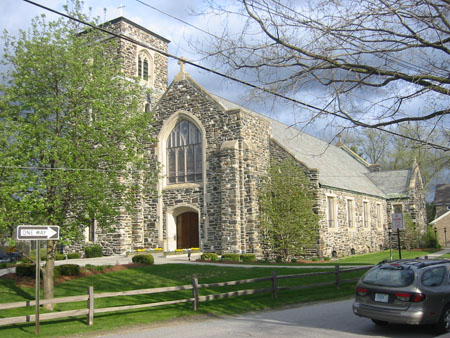
—–
[Update 11.17.2012: Broken link to Memorial Field image fixed.]
Football and the Night Visitors
Dartmouth’s and Memorial Field’s first night game under the new lights will begin at 6pm tonight against Penn.
The sports publicity office’s extraordinary promotional efforts, as chronicled by the Big Green Alert Blog, include a banner across Main Street, an advertising poster, and a drinks coaster distributed to local establishments.
Gutting the West Stand at Memorial Field
In December of 2008, Dartmouth put on hold its planned rebuilding of Memorial Field (Dartmouth News). The project would have demolished and replaced the existing steel-framed concrete grandstand, leaving the arcaded brick facade on Crosby Street. It seems that the replacement supports, made of concrete, were actually cast and have been resting in a field in Vermont, awaiting an improvement in the college budget.
Here’s hoping the project will be restarted soon.
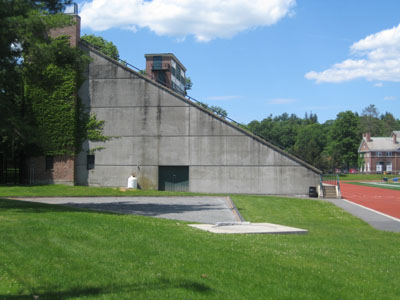
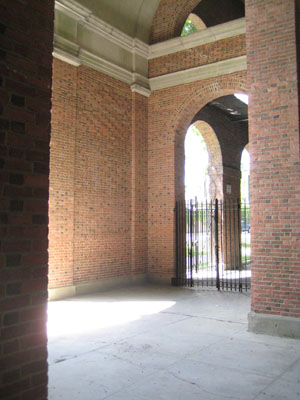

The Big Green Alert Blog has been providing extensive coverage of the installation of lights at Memorial Field (June 11, June 25 morning and afternoon, August 3) in advance of the first night game on October 1. The game will be against Penn and will begin at the extravagantly late hour of 6 pm. It will be Dartmouth’s first-ever night game at any field.
[Update 08.22.2011: Replaced line reading “The project recently was restarted” (thanks Big Green Alert Blog).]
Unbuilt Dartmouth, an exhibit and an article
A graphical article based on research by Barbara Krieger in the July/August Alumni Magazine nicely covers a larger exhibit in the History Room in Baker. It is good to see the site for the amphitheater named as Murdough rather than the Bema, which is the site that that drawing is usually said to describe.
One or two quibbles: the 1931 courtyard Inn on page 53 was meant not not the Robinson Hall area but for the Spaulding Auditorium site, as is shown on the exhibit’s Dartmouth House Plot Plan. The gateway shown in the Larson drawing would have faced east, and Lebanon Street is depicted on the left of the drawing. (The main block of the current Inn was completed in 1967 rather than 1887.)
The focus on the Dartmouth Hall cupola is a bit of a wild goose chase. The plans depicted are by William Gamble and show a masonry building that was never built. Dartmouth Hall was built from some other plans, long since lost, that almost certainly showed a cupola. Those plans might or might not have been by Gamble and probably were not by Peter Harrison. (The cupola that Tucker admired was probably a somewhat different midcentury replacement for the original.)
Here is an image that did not make it into the article, a pre-Leverone proposal for a field house by Eggers & Higgins:
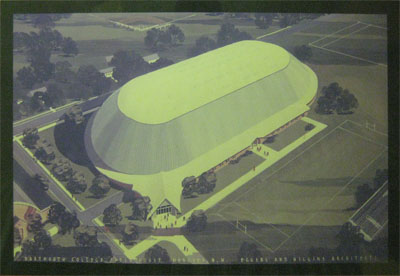
Wow. That is a view to the southeast from above the gym. South Park Street runs behind the field house, and the field in the upper right corner is the site of the later Leverone Field House.
The article quotes Eisenhower on “what a college ought to look like.” Conan O’Brien recently paraphrased this commentary while adding something of his own:
It’s absolutely beautiful here, though. It is the quintessential college cam-… American college campus. It does look like a movie set.
(Video, at 1:27.)
Memorial Field is getting lights
For the first time in nearly 120 years of football on the site, night games will be possible (The Dartmouth, Valley News, WMUR Manchester). Dartmouth Sports has a rendering.
—–
[Update 01.13.2013: Broken link to WMUR removed.]
Memorial Field west stand reconstruction delayed one year
Major remaking of Memorial Field might be about to begin
Dartmouth has planned to replace the concrete stands that make up most of Memorial Field’s main western stand for some time. The recognizable brick arcading and memorial arch will remain. The OPDC recently put a plan (pdf) and front and rear elevation drawings (pdf) on the project’s web page.
The Fleck & Lewis design preserves the street facade of the Larson building, including the tall brick attic story added above the entry in the 1950s (?) to screen the press box. Low brick cheek walls that appear to be new will flank this attic story to screen the wider replacement press box, but they are imperceptible and improve the transition from the tower to the parapet.
The field facade includes a straightforward-seeming set of replacement concrete seat risers and a new, squatter-seeming press box. The press box appears more dignified than its predecessor: its roof seems lower, and its bottom level appears to rest on a lower seating level than the old box’s did. It is certainly broader. New stair towers flanking the box introduce brick into this historically concrete facade. Like the old box, the new one will be faced in green-painted panels.
The project also appears among landscape architects Saucier & Flynn’s works in progress, and the historic field was the subject of a recent “Ask Dartmouth” query.
Now that the economic collapse has depressed Dartmouth’s endowment (story in The Dartmouth), the school has put the Memorial Field project on hold for two to six weeks to determine whether to go forward, Provost Barry Scherr and Executive V.P. Adam Keller announced on the 13th. The other projects on hold are the Visual Arts Center and the Truex Cullins renovation of Buchanan Hall (story in The Dartmouth).
The updates page for the stands renovation (updated November 3) is still announcing the start of construction as November 17.
Red Rolfe Field at Biondi Park announced
The diamond at Red Rolfe is being completely rebuilt, and, with a grandstand, dugouts, and a press box, will become part of Biondi Park. Press Release; Project page. Clark Companies and Gale Associates are the field consultants, and Lavallee Brensinger, designer of the gym renovation, is designing the grandstand. The project page has a perspective rendering available.
—–
[Update 11.17.2012: Broken link to Clark fixed.]
[Update 07.12.2008: The plans page also includes a nice site plan (pdf), and Big Green Alert Blog has a post with an aerial perspective rendering and a view of the entrance gate.]
Memorial Field demolition details
The demolition and replacement of all but the brick arcade screen of Memorial Field’s main or West Stand will be designed by Fleck & Lewis Architects. The completed building will seat 4,736 people, a number almost certainly smaller than its original capacity.
Memorial Field West Stand to be demolished; brick facade to remain
Jens Larson’s main or western stand at Memorial Field is a concrete grandstand screened by a brick facade overlooking Lebanon Street. The Big Green Alert Blog reports that the previously-announced Memorial Field project (construction to begin October 2008, occupancy September 2009, according to the schedule pdf) is more than just a renovation of the structure: the school will demolish the entire concrete stand and replace it with a new one, leaving the brick facade in place.
This project will make the stand more accessible, more comfortable, and less capacious. The likely drop in seating capacity, continuing the trend of the Floren-motivated shrinking of the East Stand, might be desirable. The green-paneled press box, which seems to be from the 1950s and is the latest in a series of expanding press boxes, also will be replaced. The replacement could be a harmonious brick design that responds to Floren, and if Centerbrook has a hand in the project, this result seems especially likely.
Memorial Field’s original West Stand as viewed from the head of the field, by Davis Field House. The distinction between the concrete stand and the applied brick facade or screen is evident. The replacement press box will probably be much wider.
The stand’s center bay contains the only “interior” and the only portion past the street front that is worth saving. This vaulted passage is the site of the memorial element of Memorial Field.
The concrete stand itself is utilitarian and not in the best condition.
Hanover projects of ORW Landscape Architects
ORW Landscape Architects & Planners of Norwich provide, among their transportation design examples, information about a project for Hanover: a set of street standards that fits with the Brook McIlroy plan.
The site includes drawings of a reworked south entrance into town (note the commercial building in the parking lot of Grand Union/CVS, as Brook McIlroy suggested); an eastern welcome by Memorial Field focused on a proposed corner tower and building on the very important site where the FO&M buildings are now; and two proposed street sections, one for Lebanon street with Brook McIlroy’s wide sidewalks for cafe seating.
The firm has also done a riverfront park design study, a trail plan, and a suburban development proposal in Lebanon, a proposal for corridor enchancements in Norwich, and a proposal for new buildings in downtown White River.
